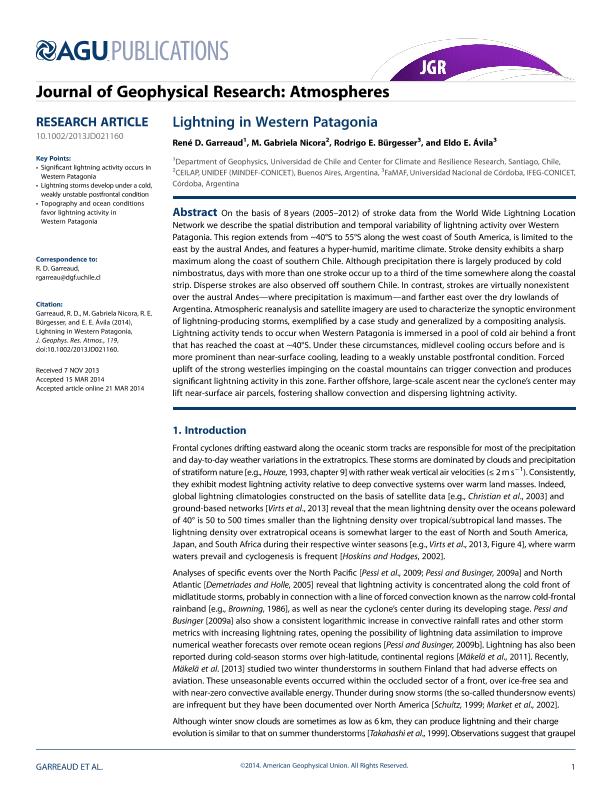Artículo
Lightning in Western Patagonia
Fecha de publicación:
04/2014
Editorial:
American Geophysical Union
Revista:
Journal of Geophysical Research
ISSN:
0148-0227
Idioma:
Inglés
Tipo de recurso:
Artículo publicado
Clasificación temática:
Resumen
On the basis of 8 years (2005–2012) of stroke data from the World Wide Lightning LocationNetwork we describe the spatial distribution and temporal variability of lightning activity over WesternPatagonia. This region extends from ~40°S to 55°S along the west coast of South America, is limited to theeast by the austral Andes, and features a hyper-humid, maritime climate. Stroke density exhibits a sharpmaximum along the coast of southern Chile. Although precipitation there is largely produced by coldnimbostratus, days with more than one stroke occur up to a third of the time somewhere along the coastalstrip. Disperse strokes are also observed off southern Chile. In contrast, strokes are virtually nonexistentover the austral Andes—where precipitation is maximum—and farther east over the dry lowlands ofArgentina. Atmospheric reanalysis and satellite imagery are used to characterize the synoptic environmentof lightning-producing storms, exemplified by a case study and generalized by a compositing analysis.Lightning activity tends to occur when Western Patagonia is immersed in a pool of cold air behind a frontthat has reached the coast at ~40°S. Under these circumstances, midlevel cooling occurs before and ismore prominent than near-surface cooling, leading to a weakly unstable postfrontal condition. Forceduplift of the strong westerlies impinging on the coastal mountains can trigger convection and producessignificant lightning activity in this zone. Farther offshore, large-scale ascent near the cyclone’s center maylift near-surface air parcels, fostering shallow convection and dispersing lightning activity.
Palabras clave:
Patagonia
,
Lightning
,
Storms
,
Wwlln
Archivos asociados
Licencia
Identificadores
Colecciones
Articulos(IFEG)
Articulos de INST.DE FISICA ENRIQUE GAVIOLA
Articulos de INST.DE FISICA ENRIQUE GAVIOLA
Citación
Garreaud, Rene; Nicora, Maria Gabriela; Burgesser, Rodrigo Exequiel; Avila, Eldo Edgardo; Lightning in Western Patagonia; American Geophysical Union; Journal of Geophysical Research; 119; 4-2014; 4471-4485
Compartir
Altmétricas




